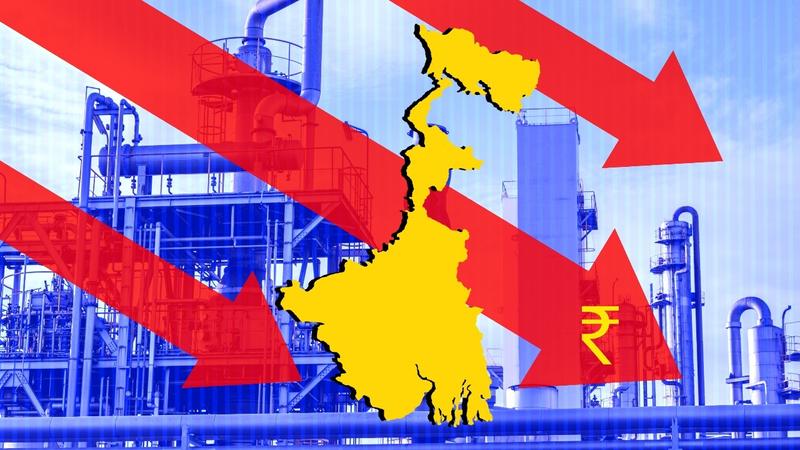Published 19:41 IST, August 24th 2024
The Industrial Bankruptcy of Bengal
Kolkata, for those who don’t know, was a laid-back city, mesmerising its residents with its charm of love, ardor, and rasgulla.

At the outset, I must say that being born and brought up in Kolkata, it pains me deeply to write this piece.
My family migrated to Kolkata about three generations ago in the early 1950s. We made Bengal our home. Not just my family, but countless others like us came to Kolkata, which in those days was an aspirational dream for a villager from the deep south of India. As Sanjeev Sanyal, a member of the Economic Council to the PM, made his controversial comment on Kolkata, "The city didn’t die, it was murdered," I cannot help but agree. Kolkata, for a large part, was ruled by the Communist Party. The bhadralok (gentleman) never turned abodhro (indecent) in fighting against the government of the day—and that, I believe, was the biggest mistake.
Kolkata, for those who don’t know, was a laid-back city, mesmerising its residents with its charm of love, ardor, and rasgulla. The charm lingered for a very long time, etched in the memories of people like me. The love will never fade, and it should never. But yes, I must admit, a part of me grew to hate what Bengal had become.
Before 1911, Bengal was the capital of British India. Post-1947, Kolkata was India’s commercial hub. Giants like the Tatas built an 18-story skyscraper in 1963 to house their East India operations. The Birlas established their empire at Chowringhee. Dum Dum was India’s largest airport, serving more international airlines than any other airport in the country. The city was bustling with life—business, culture, and sports thrived. But slowly and steadily, the Communists started imposing their left-leaning ideas, and the culture of strikes, bandhs, and hartals crept in. With a heavy dose of communism, Kolkata's glory began to fade.
Offices were open six days a week, but work barely got done on three or four of those days. I remember inter-para riots that stunned me as a young boy. Believe me, you’d be shocked to know that goons from one neighbourhood would throw handmade bombs (petos) at the next. That was the culture of the ruling class. During festivals, donations (chanda) were nothing short of extortion. Slowly, inefficiency became the norm. No one cared, and no one bothered. Bandhs in Kolkata meant free days to play cricket on the roads. Stone pelting, dharnas, strikes, latecomers, loud arguments, and endless excuses became the hallmark of Kolkata folk. They ranted about a glorious past but spent more time in adda (chit-chat) than in productive work. Businessmen and industrialists, harassed by goons, grew frustrated and began leaving, one by one.
And yet, despite it all, one thing never lost its charm—Kolkata’s street food. It still mesmerises and stuns my taste buds every time. The phuchkas, the rolls, the jhaal muri—these are the flavours that keep pulling me back to the old Calcutta, just as it draws millions of others. For many of us, this is the heart of Kolkata's magic, a piece of the city that has stubbornly refused to change even as so much else has crumbled around it.
As the city changed its name from Calcutta to Kolkata, very little actually changed in its essence. The love for cricket and football was always beyond the corridors of responsibility, where skipping work for a game or an impassioned debate over local clubs was a way of life. The city’s passions ran deep, but they also distracted from its gradual decline.
By the late 90s, Bengal was a fast-dying state. As this progressive destruction unfolded, the proud Bengali rarely realised what was happening. It wasn’t until the late 90s that the youth began to feel the heat—no jobs, no opportunities, poor pay, and lack of exposure haunted them. The younger generation began migrating to Bengaluru, Hyderabad, Chennai, and Mumbai. It was a shocking eye-opener. They realised how backward their home state had become.
The change of government did little to improve the situation. From dada to didi, things went from bad to worse. There are whispers that in between, Buddhadeb Bhattacharjee made an honest attempt to bring change, but the system was beyond repair. Singur was the final nail in the coffin. When the Tatas left Bengal, I believe that was the day Bengal's Industrial obituary was written.
Today, Bengal and Kolkata, with their glorious past, are only discussed in the past tense. The charm is lost. The youth are gone. The factories have closed. There is no hope of a new dawn. If I had to ask one question that keeps lingering in my mind, it would be this: Kothai gelo amader Kolkata? (Where did our Kolkata go?) I doubt I’ll ever get an answer.
As I sign off, I cannot help but add a note of positivity. Despite all the sadness, a human being must accept finite disappointment but never lose infinite hope. Hope is, after all, the last thing ever lost."
Disclaimer: The views and opinions expressed in this article are those of the author and do not necessarily reflect the official policy or position of Republic Business. Any content provided by our bloggers or authors is of their opinion and is not intended to malign any religion, ethnic group, club, organisation, company, individual, or anyone or anything.
Updated 20:27 IST, August 24th 2024